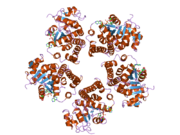Biology:PYCR1
From HandWiki
 Generic protein structure example |
Pyrroline-5-carboxylate reductase 1, mitochondrial is an enzyme that in humans is encoded by the PYCR1 gene.[1][2]
This gene encodes an enzyme that catalyzes the NAD(P)H-dependent conversion of pyrroline-5-carboxylate to proline. This enzyme may also play a physiologic role in the generation of NADP(+) in some cell types. The protein forms a homopolymer and localizes to the mitochondrion. Alternate splicing results in two transcript variants encoding different isoforms.[2] As reported by Bruno Reversade and colleagues, PYCR1 deficiency in humans causes a progeroid disease known as De Barsy Syndrome mainly affecting connective tissues with dermis thinning and bone fragility.[3]
References
- ↑ "Cloning human pyrroline-5-carboxylate reductase cDNA by complementation in Saccharomyces cerevisiae". The Journal of Biological Chemistry 267 (2): 871–5. January 1992. doi:10.1016/S0021-9258(18)48364-0. PMID 1730675.
- ↑ 2.0 2.1 "Entrez Gene: PYCR1 pyrroline-5-carboxylate reductase 1". https://www.ncbi.nlm.nih.gov/sites/entrez?Db=gene&Cmd=ShowDetailView&TermToSearch=5831.
- ↑ "Mutations in PYCR1 cause cutis laxa with progeroid features". Nature Genetics 41 (9): 1016–21. September 2009. doi:10.1038/ng.413. PMID 19648921.
Further reading
- "Human colon tumors: enzymic and histological characteristics". Cancer 42 (3): 1280–3. September 1978. doi:10.1002/1097-0142(197809)42:3<1280::AID-CNCR2820420337>3.0.CO;2-P. PMID 212173.
- "Purified human erythrocyte pyrroline-5-carboxylate reductase. Preferential oxidation of NADPH". The Journal of Biological Chemistry 264 (16): 9352–8. June 1989. doi:10.1016/S0021-9258(18)60538-1. PMID 2722838.
- "The effect of pyrroline-5-carboxylic acid on nucleotide metabolism in erythrocytes from normal and glucose-6-phosphate dehydrogenase-deficient subjects". The Journal of Biological Chemistry 259 (9): 5454–8. May 1984. doi:10.1016/S0021-9258(18)91032-X. PMID 6201483.
- "Enzyme activities in human fetal and neoplastic tissues". Cancer 46 (9): 2047–54. November 1980. doi:10.1002/1097-0142(19801101)46:9<2047::AID-CNCR2820460924>3.0.CO;2-Q. PMID 6253048.
- "Pyrroline-5-carboxylate reductase in human erythrocytes". The Journal of Clinical Investigation 67 (4): 1042–6. April 1981. doi:10.1172/JCI110115. PMID 6894153.
- "Oligo-capping: a simple method to replace the cap structure of eukaryotic mRNAs with oligoribonucleotides". Gene 138 (1–2): 171–4. January 1994. doi:10.1016/0378-1119(94)90802-8. PMID 8125298.
- "Pyrroline-5-carboxylate reductase in lactating bovine mammary glands". Journal of Dairy Science 79 (8): 1361–8. August 1996. doi:10.3168/jds.S0022-0302(96)76493-7. PMID 8880459.
- "Construction and characterization of a full length-enriched and a 5'-end-enriched cDNA library". Gene 200 (1–2): 149–56. October 1997. doi:10.1016/S0378-1119(97)00411-3. PMID 9373149.
- "Crystal structure of human pyrroline-5-carboxylate reductase". Journal of Molecular Biology 359 (5): 1364–77. June 2006. doi:10.1016/j.jmb.2006.04.053. PMID 16730026.
External links
- PDBe-KB provides an overview of all the structure information available in the PDB for Human Pyrroline-5-carboxylate reductase 1, mitochondrial (PYCR1)





